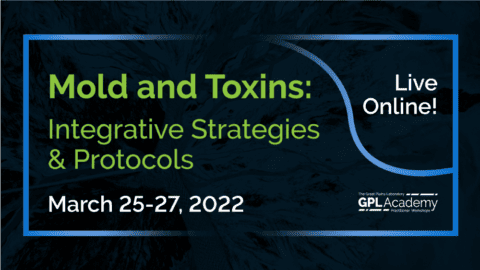ABSTRACT
A child with autism was found to have complete IgA deficiency (serum IgA < 6 mg/dL; normal 33-235 mg/dL), Candidiasis of the gastrointestinal tract based on evaluation of stool testing and elevated urine arabinose, and elevated serum antibodies to wheat and dairy products. The pretreatment urinary arabinose concentration (341 mmol/mol creatinine in this child was nearly six times the mean value (60.4 mmol/mol creatinine, n=20) of normal children and over ten times the median value (31.0 mmol/mol creatinine) of normal controls. After antifungal therapy for four months, the urine was retested. At that time the urine arabinose was measured at 51 mmol/mol creatinine, a value only 15% of the baseline sample. Restriction of wheat and dairy products from the diet and antifungal therapy led to a significant decrease in autistic behaviors and increased rate of learning. The Childhood Autism Rating Scale (CARS), an observational measure of various aspects of autism, for the child has decreased from a rating of 43 (severely autistic) prior to introduction of these therapies to a value of 29 (non-autistic) after therapy.
INTRODUCTION
Studies done by the late Reed Warren Ph.D. at Utah State University and others indicate that most children with autism have a substantial immune abnormality of some type (1-20). Kontstantareas and Homatidis (21) at the University of Guelph in Ontario, Canada found a high correlation between the prevalence of ear infections and the incidence of autism. They found that the earlier the child had an ear infection, the more likely that child had a more severe form of autism. They also found that increased incidence of ear infections was associated with a more severe rather than a mild form of autism. Candida infection has been reported as a consequence of frequent antibiotic usage in both humans and animals (22-30) and an abnormal increase in the sugar arabinose probably from Candida has been reported in urine samples of two siblings with autism (31). However, Candida infection may also be common in children with immunodeficiencies who do not have an unusually high number of infections treated with antibiotics. The pattern of gastrointestinal Candida overgrowth, immunodeficiency, metabolic disorder and autism is well illustrated in the medical history of the child evaluated by us.
PREVIOUS MEDICAL EVALUATION
The child evaluated is a five-year-old Caucasian male with a normal birth at term and normal apgar scores. Newborn metabolic screens for phenylketonuria, hypothyroidism, galactosemia, and sickle-cell disease were within normal limits. Both parents are college graduates; both parents are considered socially well adjusted. The maternal grandmother suffered from multiple sclerosis and is now deceased. The maternal grandfather died secondary to viral cardiomyopathy; as a child he did not speak until three years of age but then talked and developed normally. The paternal grandparents are in good health.
A pediatric ophthalmologist evaluated the child at six months of age for intermittent crusting and tearing of the left eye, which was non-responsive to antibiotic drops. The patient had surgery for the blocked tear-duct and a possible undescended testicle at 16 months. Exploratory surgery did not locate the missing testicle; the patient was put on prophylactic antibiotics after surgery. Up to the age of three years, the patient had had only one or two ear infections treated by antibiotics, a couple of colds, and an upper respiratory infection. Immunizations were all on schedule. A routine physical examination at 15 months of age assessed development as normal although parents expressed concerns about lack of speech. The MMR vaccine was administered at this checkup. Assessment by the pediatrician at 18 months was “healthy 1.5 year old” who “does not need to return until 2 years of age.” Deficiency of expressive language was noted in the medical record but the parents were not advised to seek additional consultation.
At a pediatric evaluation at 2 years of age, lack of expressive language (only 5 words) was again noted but no follow-up was recommended. At a pediatric evaluation at 2.5 years of age, no expressive language was noted and the child was referred to a hearing and speech clinic for evaluation. Diet was noted to consist of bread, pancakes, milk, peanut butter, and chicken. He was noted to always have loose stools. The subsequent hearing evaluation revealed normal hearing but recommended a developmental assessment of the child. Three months later at the age of 27 months, the child was diagnosed with autism by a developmental pediatrician at a university autism clinic using DSM-IV diagnostic criteria; developmental age was assessed as at the 19-20 month level. At this exam, otitis media was diagnosed and treated with Amoxicillin. A MRI scan of the head revealed some atrophy of the frontotemporal lobe. EEG and fragile X chromosome studies were normal. The child was seen by a second university autism clinic in another state, which confirmed the original diagnosis. The parents of the child were referred to support groups, to speech therapists, and to special schools for education and behavioral modification but were not referred for any evaluation of the child’s immune or gastrointestinal function.
When the child was 4.75 years of age, the parents decided to embark on additional biochemical assessments of their child including allergy assessment, routine chemistry and hematology, evaluation of stool microorganisms, evaluation of immune function, and urine organic acid testing.
Comprehensive food allergy testing for 96 foods was performed using IgG specific enzyme linked immunoassay. The following allergens were positive by IgG-specific enzyme linked immunoassay: barley, gluten, wheat, bran, cow’s milk, cheeses (cheddar, cottage, and Swiss), beef, grapefruit, orange, peanut, soybean, and sugar. The IgA endomysial antibody test, which is considered to be specific for celiac disease, was negative in this child.
Normal serum values were found for all of the following: glucose, urea nitrogen, creatinine, total protein, albumin, total bilirubin, alkaline phosphatase, AST, ALT, LDH, calcium, phosphorus, blood lead, sodium, potassium, chloride, bicarbonate, uric acid, triglycerides, cholesterol, anion gap, thyroxine, antinuclear antibodies, thyrotropin (highly sensitive), iron, copper, magnesium, cortisol, zinc, and ferritin. White cell count was slightly low (4900/mm3); normal: 5500-15,500/mm.3 Hemoglobin and hematocrit were normal. The white cell differential was normal except for a slight elevation of atypical lymphocytes. The absolute number and percentage of CD3, CD4, and CD8 cells, evaluated by flow cytometry were all within normal limits.
Analysis of serum immunoglobulins revealed normal values for serum IgG, IgM, IgE, and IgG subclasses but undetectable values for serum IgA (Table 1). Stool analysis revealed a 4+ overgrowth of Candida parapsilosis; normal is 0 and the highest possible overgrowth is 4+. Antifungal sensitivity of the organism indicated sensitivity to fluconazole, itraconazole, nystatin, and ketoconazole. Bacteria in the stool sample usually considered beneficial were Lactobacillus (2+) and Bifidobacteria (4+). Stool analysis also revealed 3+ levels of gamma streptococci and 4+ hemolytic E. coli. An evaluation of a urine sample by gas chromatography-mass spectrometry as described previously (31) taken at the same time indicated significant increases of the sugar arabinose as the major abnormality; there were no abnormalities associated with any recognized inborn error of metabolism.
THERAPY
Because of elevated Candida in the stool sample, indicating a gastrointestinal yeast overgrowth, the child was placed on 100,000 Units nystatin four times a day plus alternating weeks of Nizoral or Diflucan (2 mg/kg) and was also placed on a gluten and casein free diet approximately two months after beginning antifungal therapy. Both dietary and antifungal therapies are continuing five months later. The pretreatment urinary arabinose concentration (341 mmol/mol creatinine in this child was nearly six times the mean value (60.4 mmol/mol creatinine, n = 20) of normal children and over ten times the median value (31.0 mmol/mol creatinine) of normal controls. After antifungal therapy for four months, the urine was retested. At that time the urine arabinose was measured at 51 mmol/mol creatinine, a value only 15% of the baseline sample. With two additional months of antifungal treatment, the urine arabinose value decreased to 26 mmol/mol creatinine. A follow-up stool test indicated the absence of Candida in the sample.
RESULTS OF THERAPEUTIC INTERVENTIONS
The mother of the child reports a significant increase in eye contact, a significant decrease in self-stimulatory behavior, and increased use of spontaneous language shortly after beginning antifungal therapy. After beginning the casein and gluten free diet, the mother reports the child was able to follow three step verbal directions versus only one step directions previously. The mother also reported increased learning speed in the schooling program, increased verbal labeling, and increased spontaneous verbal initiations. The score for the child on the Childhood Autism Rating Scale (CARS), an observational measure of various aspects of autism has decreased from a rating of 43 (severely autistic) prior to introduction of these therapies to a value of 29 (non-autistic) after therapy. Cutoff for autism is 30 or above. The child is now considered by the assessment team at the state university autism clinic to be a high-functioning individual with autism. The child can now parallel play with other children in class, demonstrates an interest in peers, shares toys, and is engaging in some imaginative play.
DISCUSSION
Selective IgA deficiency
The most striking laboratory abnormality of this child is the absence of detectable IgA. IgA is the antibody that is involved with protection of the lining of the nasal passages and intestinal lining from microorganisms. Secretory IgA or sIgA is a special form of the IgA antibody that is secreted to protect the mucosa, which is the lining of the intestinal tract. Secretory IgA on a stool sample from this child was also noted as deficient. Secretory IgA is apparently secreted by the gall bladder and then trickles down the bile ducts into the small intestine. Some children with autism such as this one have very low or even completely absent levels of IgA (1,20); in such cases there is probably also a deficiency of a secretory IgA since secretory IgA is derived from IgA.
This extremely common immunodeficiency occurs in 1 in 600-1000 persons of European ancestry (32). The causes of IgA deficiency are not completely known. There are some cases in which the deficiency runs in families while in other cases it does not. It has been reported in association with abnormalities of chromosome 18, but most individuals with IgA deficiency have no detectable chromosomal abnormalities (32). IgA deficiency may also be caused by drugs or viral infection (rubella, cytomegalovirus, toxoplasmosis) and may be also be associated with intrauterine infections. Patients with IgA deficiency are usually deficient in both subtypes of IgA, IgA1 and IgA2.
In Gupta’s study (20), 20% of the children with autism had a deficiency of IgA and 8% lacked it completely. Reed Warren and his colleagues (1) also found that 20% of individuals with autism had low serum IgA compared with none of the normal controls. Thus, complete IgA deficiency in autism is somewhere between 48 and 80 times higher in the autism population compared to a normal Caucasian population.
IgA replacement therapy cannot be used currently because the short half-life of IgA would make it an extremely expensive therapy. However, bovine colostrum, which is commercially available, is high in IgA and might be considered as a possible therapy for IgA-deficient patients. IgG therapy can be used with patients with low IgA values. If the IgA values are so low that they cannot even be detected, however, giving IgG therapy is too risky. It is possible that the immunodeficient person’s body would produce antibodies against IgA present in gamma globulin, causing potentially fatal anaphylactic shock.
The clinical consequences of IgA deficiency range from severe systemic infection to a perfectly healthy state. Many IgA-deficient persons are never aware of their antibody deficiency while others may have recurrent infections, allergic diseases, and autoimmune diseases (32). This child with autism had significant Candidiasis of the gastrointestinal tract despite the fact that the child had only two courses of antibiotics during his lifetime. Thus, intestinal Candidiasis following antibiotic therapy appears to be a much greater risk in a child with immunodeficiency. The decrease in symptoms of autism after antifungal therapy and gluten and casein restriction has been noted in many children with autism (33). (The authors are aware of three children with autism diagnosed at university autism centers who are now considered symptom-free after antifungal treatment and gluten and casein restriction.)
The child being presented was never considered a “sickly” child by the parents. It is possible that the difficult to treat eye crusting may have been related to the IgA deficiency since IgA is secreted in tears, saliva, and gastric juice; the deficient IgA in the tears may have led to a greater number of eye infections. The occurrence of multiple sclerosis in the maternal grandmother might be of significance but she was never evaluated for IgA deficiency. The remarkable spectrum of clinical manifestations of this immunodeficiency may be related to variations in the ability to replace IgA antibodies in the mucous secretions with IgM antibodies. IgG2 and IgG4 subclass deficiencies are common in IgA deficiency but were not present in this individual.
IGA DEFICIENCY AND CELIAC DISEASE
The incidence of selective IgA deficiency is 10 times higher in patients with celiac disease compared to the general population (34). The diagnosis of celiac disease cannot be excluded in an IgA deficient child because the endomysial antibody test uses IgA antibody specificity and may yield false negative results in such cases (35) so the possibility that the child may have celiac disease cannot be excluded. The parents elected to place the child on a wheat and dairy-free diet based on the ELISA-allergy test results so a diagnosis of celiac disease by intestinal biopsy would not be valid for this child. Positive IgG antibodies to gluten were found in 100% of IgA-deficient persons with biopsy proven celiac disease but who were negative by the endomysial antibody test (35). Most children with autism are sensitive to both gluten, the major protein in wheat and barley, and to casein, the major protein in cow’s milk (36-40). Elevation of IgG antibodies to wheat, barley, and several dairy products is common in autism even though most children with autism do not have celiac disease (36-40). Behavioral improvements after restriction of gluten and casein are attributed to a decrease in peptides (casomorphin and gliadorphin) derived from gluten and casein that have central nervous system opioid effects (36-40).
CANDIDIASIS AND ABNORMAL ARABINOSE: POSSIBLE IMPLICATIONS IN BRAIN STRUCTURE AND FUNCTION
The exact biochemical role of elevated arabinose is unknown but a closely related sugar alcohol, arabitol, has been used as a biochemical indicator of invasive candidiasis (41-43). We have never found elevated arabitol in thousands of urine samples tested, including many samples with elevated arabinose and high yeast counts in the stool. Elevated arabinose in the urine of two brothers with autism was first reported by Shaw et al. in 1995 (31) and has since then has been reported to be prevalent in urine samples from people with autism (33); values as high as 4000 mmol/mol creatinine have been found in children with autism (unpublished data). We have found arabitol but not arabinose in the culture media of multiple isolates of Candida albicans isolated from stool samples of autistic children (unpublished data). Presumably elevated arabitol in the urine may only occur in systemic rather than gastrointestinal Candidiasis since arabitol in portal blood is converted to arabinose in the liver. Arabinose in the urine decreased markedly after antifungal therapy, concomitantly with an elimination of stool Candida. Arabinose, a sugar aldehyde or aldose reacts with the epsilon amino group of lysine in a wide variety of proteins and may then form cross-links with arginine residues in an adjoining protein (44), thereby cross-linking the proteins and altering both biological structures and functions of a wide variety of proteins (Figure 1) including proteins involved in the interconnection of neurons. Decreased clinical symptoms of autism after antifungal treatment would be due to decreased arabinose and pentosidine formation, resulting in fewer random neural connections (neural noise) and increased numbers of neural connections that are oriented to the child’s environment.
This adduct of arabinose, lysine, and arginine is called a pentosidine (Figure 1). The epsilon amino group of lysine is a critical functional group of many enzymes to which pyridoxal (vitamin B-6), biotin, and lipoic acid are covalently bonded during coenzymatic reactions (45); the blockage of these active lysine sites by pentosidine formation may cause functional vitamin deficiencies even when nutritional intake is adequate. In addition, this epsilon amino group of lysine may also be important in the active catalytic site of many enzymes. Protein modification caused by pentosidine formation is associated with crosslink formation, decreased protein solubility, and increased protease resistance. The characteristic pathological structures called neurofibrillary tangles associated with Alzheimer disease contain modifications typical of pentosidine formation. Specifically, antibodies against pentosidine react strongly to neurofibrillary tangles and senile plaques in brain tissue from patients with Alzheimer disease (46). In contrast, little or no reaction is observed in apparently healthy neurons of the same brain.
Thus, it appears that the neurofibrillary tangles of Alzheimer’s disease may be caused by the pentosidines. The modification of protein structure and function caused by arabinose could account for the biochemical and insolubility properties of the lesions of Alzheimer disease through the formation of protein crosslinks. Similar damage to the brains of autistic children might also be due to the pentosidines; neurofibrillary tangles have also been reported in the brain tissue of an individual with autism (47). Improvement of symptoms of autism after antifungal therapy might be mainly due to a decrease in the concentration of arabinose and a concomitant decrease in the production of pentosidine cross-links. Since pyridoxal (vitamin B-6) reacts with the same critical epsilon amino group of lysine, it is possible that the beneficial effects of vitamin B-6 in autism reported in multiple studies (48) may be mediated by prevention of further pentosidine formation. Analysis of brain tissue of people with autism for increased brain pentosidines could be invaluable in the confirmation of this hypothesis.
Women with vulvovaginitis due to Candida were found to have elevated arabinose in the urine (49); restriction of dietary sugar brought about a dramatic reduction in the incidence and severity of the vulvovaginitis. Thus, one of the mechanisms of action of antifungal drug therapy for autism might be to reduce the concentration of an abnormal carbohydrate produced by the yeast that can not be tolerated by the child with defective pentose metabolism or an inability to remove harmful pentosidines. Arabinose tolerance tests should be able to rapidly determine if such biochemical defects are present in children with autism.
A MODEL FOR AUTISM
The success of Gupta (20) in treating the autistic symptoms of children with autism with gamma globulin therapy indicates an immune abnormality in autism. Based on these findings and our findings of abnormal arabinose and other organic acids in other children with autism (31,33), we propose the following model for autism (Figure 2). According to this model, immune deficiencies, which may be genetic or acquired, lead to an increased frequency of infections, which in the United States are almost always treated with broad-spectrum oral antibiotics that result in intestinal yeast overgrowth. Furthermore, many isolates of Candida albicans produce gliotoxins (50,51) and other immunotoxins (52,53) which impair the immune system and increase the likelihood of additional infections which lead to additional antibiotic usage and greater proliferation of yeasts and antibiotic-resistant bacteria, setting up a vicious cycle. These organisms produce high amounts of abnormal carbohydrates such as arabinose and Krebs cycle analogs such as citramalic and tartaric acids (31).
There is no inherent reason that dramatic biochemical changes in multiple biochemical systems caused by microorganisms would not be expected to alter brain structure and function. In PKU, correction of the metabolic defect by restriction of phenylalanine during infancy allows for normal development; negative impacts on development occur if dietary intervention occurs too late. If abnormally elevated metabolites cause autism, then it is reasonable to think that elevations of these compounds would have maximum negative impact during periods of critical brain growth and development. As in PKU, metabolic intervention in autism might only be possible in the early stages of the disorder before the brain has matured. The differences in severity of disease and individual differences in symptoms might be due to different combinations of metabolites, how elevated they are, the duration of the elevation, the age at which the metabolites become abnormally elevated, and the susceptibility of the individual developing nervous system to the different microbial metabolites.
Some children with autism have a history of frequent infections: two different parents of children with autism indicated to the authors that their children had over 50 consecutive infections (predominantly otitis media) treated with antibiotics. However, some children with autism such as the child presented here did not have excessive use of oral antibiotics and was not considered to be a “sickly child” by the parents or attending physicians. In this child the underlying immune deficiency and two uses of antibiotics apparently led to a persistent yeast overgrowth of the intestinal tract.
GENETIC IMMUNODEFICIENCIES PROPOSED AS THE MAJOR GENETIC FACTORS IN AUTISM
Ritvo et al. (54) found a concordance rate for autism of 23.5% in dizygotic twins and 95.7% in monozygotic twins, indicating a strong genetic basis for autism. However, the results of the Stanford autism genetics study of 90 families affected by autism (55) indicate ” that there are no genes with a major effect for autism. That is, our analyses show that autism is almost surely not a simple single major gene disorder, such as Huntington disease. Rather, the analyses from these 90 families indicate that there are likely to be a relatively large number of different genes related to the susceptibility for autism, each with a minor effect.” We suspect that many of these “relatively large number of genes” are those that regulate the immune system. We have been impressed with the large number of studies that have indicated a wide number of abnormalities of the immune system in autism (1-20) including IgG deficiency, IgA deficiency, IgG subclass deficiency, myeloperoxidase deficiency (a genetic defect in an enzyme of the leukocytes that produces hypochlorite ion to kill yeast), reduced natural killer cell activity, markedly elevated serum levels of the cytokines interleukin-12 and interferon-gamma, increased anti-myelin and serotonin receptor antibodies, increased DR+ T cells, and a deficiency in complement C4b. In addition, some immune abnormalities in autism have been linked to adverse reactions to vaccinations (56). The two brothers with autism in which abnormal arabinose and abnormal organic acids were first reported (31) both had abnormally low concentrations of serum IgG. Autism has also been diagnosed in other children with defined inborn errors of metabolism such as biotinidase deficiency and isovaleric acidemia (Lombard, Personal Communication) in which yeast infections are common.
Efforts to locate a single autism gene would fail since any genetic factor that severely impairs the immune system may eventually lead to the proliferation of antibiotic-resistant yeasts and bacteria which then alter behavior of children at critical periods of development through the excretion of abnormal microbial metabolic products. Thus, autism appears to be a complex metabolic disorder involving immune deficiencies, autoimmune abnormalities, abnormal food sensitivities, and gastrointestinal microbial overgrowths that may result in altered human metabolism and protein function.
Figure 1. Reaction of arabinose from yeast with amino groups of lysine to form a Schiff base adduct. The rearranged Schiff base then reacts with a guanido group on an arginine residue of a second protein, resulting in two different proteins crosslinked through a pentosidine moiety.
Figure 2. Immunodeficiency model for autism. In this model, immunodeficiencies lead to antibiotic use that stimulates yeast overgrowth (primarily Candida) of the gastrointestinal tract. Certain strains of Candida produce immunosuppressant compounds called gliotoxins that further weaken the immune system and may lead to additional infections. Arabitol produced by Candida in the gastrointestinal tract is converted to arabinose by the liver. Elevated arabinose then leads to pentosidine formation, leading to increased neurofibrillary tangles in the brain.
CLINICAL REFERENCES
- 1. Warren R, Odell J, Warren W, Burger R, Maciulis A, Daniels W, Torres A. Immunoglobulin A deficiency in a subset of autistic subjects. J. Autism Develop Dis. 27:187-192,1997.
- 2. Warren R, Margaretten N, Pace N, Foster A. Immune abnormalities in patients with autism. J. Autism Develop Dis. 16, 189-197, 1986.
- 3. Warren R, Singh V, Cole P, Odell J, Pingree C, Warren L, DeWitt C, and McCullough M. Possible association of the extended MHC haplotvpe B44-SC30-DR4 with autism. Immunogenetics 36: 203-207, 1992.
- 4. Warren R, Yonk J, Burger R, Odell J, Warren W. DR positive T cells in autism: association with decreased plasma levels of the complement C4B protein. Neuropsychobiology 31: 53-57, 1995.
- 5. Singh, V, Warren, RP, Odell, JD, and Cole, P. Changes in soluble interleukin-2, interleukin-2 receptor, T8 antigen, and interleukin-I in the serum of autistic children. Clin. Immunol. Immunopath. 61: 448-455, 1991.
- 6. Yonk LJ, Warren RP, Burger RA, Cole P, Odell JD, Warren WL, White E, Singh VK: CD4+ helper T cell depression in autism. Immunol Lett 25: 341-346, 1990.
- 7. Abramason RK, Self S, Genco P, Smith N, Pendleton A, Valentine J, Wright HH, Cuccaro M, Powell D: The relationship between lymphocyte cell surface markers and serotonin in autistic probands (abstract). Am J Hum Genet 47(3):A45, 1990.
- 8. Wood Frei B, Dennv D, Gaffney GR, O’DonneU T: Lymphocyte subsets and the interleukin-2 system in autistic children (abstract). Sci Proc Annu Meet Am Acad Child Adolesc Psychiatry 7: 53, 1991.
- 9. Plioplys AV, Greaves A, Kazemi K, Silverman E. Lymphocyte function in autism and Rett syndrome. Neuropsychobiology 7: 12-16, 1994.
- 10. Stubbs EG, Crawford ML, Burger DR, Vanderbark AA: Depressed lymphocyte responsiveness in autistic children. J Autism Child Schizophr 7:49-55, 1977.
- 11. Warren R, Yonk L, Burger R, Cole P, Odell J, Warren W, White E, Singh V. Deficiency of suppressor-inducer (CD4+CD45R+) T cells in autism. Immunol Invest 19:245-251,1990.
- 12. Singh VK, Fudenberg HH, Emerson D, Coleman M: Immunodiagnosis and immunotherapy in autistic children. Ann NY Acad Sci 540:602-604, 1988.
- 13. Ferrari P, Marescot M, Moulias R, Bursztejn C, Deville-Chambrolle A, Thiolett M, Lesourd B, Braconnier A, Dreux C, Zarifian E. Immune status in infantile autism: Correlation between the immune status, autistic symptoms and levels of serotonin. Encephale 14: 339-344, 1988.
- 14. Warren RP, Foster A, Margaretten NC: Reduced natural killer cell activity in autism. J Am Acad Child Psychol 26: 333-335, 1987.
- 15. Warren PP, Singh VK, Cole P, Odell JD, Pingree CB, Warren WL, White E: Increased frequency of the null allele at the complement C4B locus in autism. Clin Exp Immunol 83: 438-440, 1991.
- 16. Weizman A, Weizman R, Szekely GA, Wijsenbeek H, Livini E: Abnormal immune response to brain tissue antigen in the syndrome of autism. Am J Psychiatry 139:1462-1465,1982.
- 17. Singh VK, Warren RP, Odell JD, Warren WL, Cole P: Antibodies to myelin basic protein in children with autistic behavior. Brain Behav Immunity 7: 97-103,1993.
- 18. Plioplys AV, Greaves A, Kazemi K, Silverman E. Immunoglobulin reactivity in autism and Rett’s syndrome. Dev Brain Dysfunct 7: 12-16, 1994.
- 19. Todd R, Ciaranello R. Demonstration of inter- and intraspecies differences in serotonin binding sites by antibodies from an autistic child. Proc Nat Acad Sci 82:612-616, 1985.
- 20. Gupta S., Aggarwal and Heads C. Dysregulated immune system in children with autism. Beneficial effects of intravenous immune globulin on autistic characteristics. Autism Develop Dis 26:439-452, 1996.
- 21. Kontstantareas M and Homatidis S. Ear infections in autistic and normal children. J Autism and Dev Dis 17:585,1987.
- 22. Guentzel M and Herrera C. Effects of compromising agents on candidosis in mice with persistent infections initiated in infancy. Infection and Immunity 35: 222-228,1982.
- 23. Kennedy M and Volz P Dissemination of yeasts after gastrointestinal inoculation in antibiotic-treated mice. Sabouradia 21:27-33, 1983.
- 24. Danna P, Urban C, Bellin E, and Rahal J. Role of Candida in pathogenesis of antibiotic-associated diarrhoea in elderly patients. Lancet 337: 511-14, 1991.
- 25. Ostfeld E , Rubinstein E, Gazit E, Smetana Z. Effect of systemic antibiotics on the microbial flora of the external ear canal in hospitalized children. Pediat 60: 364-66, 1977.
- 26. Kinsman OS, Pitblado K. Candida albicans gastrointestinal colonization and invasion in the mouse: effect of antibacterial dosing, antifungal therapy, and immunosuppression. Mycoses 32:664-74,1989.
- 27. Van der Waaij D. Colonization resistance of the digestive tract–mechanism and clinical consequences. Nahrung 31:507-17, 1987.
- 28. Samonis G and Dassiou M. Antibiotics affecting gastrointestinal colonization of mice by yeasts. Chemotherapy 6: 50-2, 1994.
- 29. Samonis G, Gikas A, and Toloudis P. Prospective evaluation of the impact of broad-spectrum antibiotics on the yeast flora of the human gut. European Journal of Clinical Microbiology & Infectious Diseases 13:665-7, 1994.
- 30. Samonis G, Gikas A, and Anaissie E. Prospective evaluation of the impact of broad-spectrum antibiotics on gastrointestinal yeast colonization of humans. Antimicrobial Agents and Chemotherapy 37: 51-53, 1993.
- 31. Shaw W, Kassen E, and Chaves E. Increased excretion of analogs of Krebs cycle metabolites and arabinose in two brothers with autistic features. Clin Chem 41:1094-1104, 1995.
- 32. Butler J and Cooper M. Antibody deficiency diseases. In The Metabolic Basis of Inherited Disease. Sixth Edition. Volume II. Edited by C. Scriver et al. Pgs 2683-2696,1989, McGraw Hill, NY
- 33. Shaw W, Semon B, Rimland B, Scott P, Lewis L, and Seroussi K. Biological Treatments for Autism and PDD. Sunflower Press, Overland Park, KS, USA, 1998.
- 34. Thomas, HC and Jewell, DP. Gastrointestinal Immunology. Oxford: Blackwell Scientific Publications. Pgs 100-120, 1979.
- 35. Cataldo F, Marino V, Bottaro G, Greco P, Ventura A. Celiac disease and selective immunoglobulin A deficiency. J Pediatr 131:306-308, 1997.
- 36. Reichelt K, Ekrem J, Scott H. Gluten, milk proteins and autism: dietary intervention effects on behavior and peptide secretion. Journal of Applied Nutrition 42: 1-11, 1990.
- 37. Reichelt K, Hole K, Hamberger A, Saelid G, Edminson PD, Braestrup CB, Lingjaerde O, Ledaal P, Orbeck H. Biologically active peptide-containing fractions in schizophrenia and childhood autism, Adv Biochem Psychopharmacol 28: 627-43, 1981.
- 38. Reichelt K, Knivsberg A, Lind G, Nodland M. Probable etiology and possible treatment of childhood autism. Brain Dysfunction 4: 308-19, 1991.
- 39. Reichelt K, Knivsberg A, Nodland M, Lind G. Nature and consequences of hyperpeptiduria and bovine casomorphins found in autistic syndromes. Developmental Brain Dysfunction 7: 71-85, 1994.
- 40. Reichelt K, Saelid G, Lindback T, Boler JB. Child autism: a complex disorder. Biological Psychiatry 21: 1279-90, 1986.
- 41. Kiehn T, Bernard E, Gold J, and Armstrong D. Candidiasis: detection by gas-liquid chromatography of D-arabinitol, a fungal metabolite, in human serum. Science 206: 577-580, 1979.
- 42. Wong B, Brauer K, Clemens J, and Beggs S. Effects of gastrointestinal candidiasis, antibiotics, dietary arabinitol, and cortisone acetate on levels of the Candida metabolite D-arabinitol in rat serum and urine. Infect Immunol 58:283-288,1990.
- 43. Roboz J and Katz R. Diagnosis of disseminated candidiasis based on serum D/L arabinitol ratios using negative chemical ionization mass spectrometry. J Chromatog 575: 281-286,1992.
- 44. Sell D and Monnier V. Structure elucidation of a senescence cross-link from human extracellular matrix. Implication of pentoses in the aging process. J Biol Chem 264: 21597-21602, 1989.
- 45. Mahler H and Cordes E. Biological Chemistry. Harper and Row, NY, 1966, pgs 322-375.
- 46. Smith MA, Taneda S; Richey PL; Miyata S; Yan SD; Stern D; Sayre LM; Monnier VM; Perry G.. Advanced Maillard reaction end products are associated with Alzheimer disease pathology. Proc Natl Acad Sci USA 91: 5710-5714 , 1994.
- 47. Hof PR, Knabe R; Bovier P; Bouras C. Neuropathological observations in a case of autism presenting with self-injury behavior. Acta Neuropathol (Berl) 82: 321-6, 1991.
- 48. Rimland B. New hope for safe and effective treatments for autism. Autism Research Review International 8: 3,1994.
- 49. Horowitz B, Edelstein S, and Lipman L. Sugar chromatography studies in recurrent vulvovaginitis. J Reproductive Medicine 29:441-443,1984.
- 50. Shah D and Larsen B. Identity of a Candida albicans toxin and its production in vaginal secretions. Med Sci Res 20:353-355,1992.
- 51. Shah D and Larsen B. Clinical isolates of yeast produce a gliotoxin-like substance. Mycopathologia 116:203-208,1991.
- 52. Podzorski R, Herron M, Fast D, Nelson R. Pathogenesis of candidiasis. Immunosuppression by cell wall mannan metabolites. Arch Surgery 124: 1290-1294,1989.
- 53. Witkin, S. Defective immune responses in patients with recurrent candidiasis. Infections in Medicine. May / June pg 129-132,1985.
- 54. Ritvo, E, Freeman B, Mason-Brothers A, Mo A, and Ritvo A. Concordance for the symptoms of autism in 40 pairs of afflicted twins. American J Psychiatry 142: 74-77,1985.
- 55. Risch N, Myers R, Spiker D, Lotspeich L. The results of the Stanford Autism Genetics Project. Proceedings of the National Symposium of the Autism Society of America, Reno, NV, July 1998.
- 56. A J Wakefield, S H Murch, A Anthony, J Linnell, D M Casson, M Malik, M Berelowitz, A P Dhillon, M A Thomson, P Harvey, A Valentine, S E Davies, J A Walker-Smith. Ileal-lymphoid-nodular hyperplasia, non-specific colitis, and pervasive developmental disorder in children Lancet 1998; 351: 637-641.





